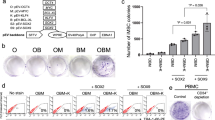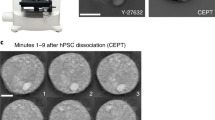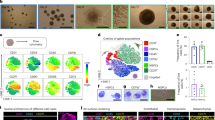Abstract
Several human postnatal somatic cell types have been successfully reprogrammed to induced pluripotent stem cells (iPSCs). Blood mononuclear cells (MNCs) offer several advantages compared with other cell types. They are easily isolated from umbilical cord blood (CB) or adult peripheral blood (PB), and can be used fresh or after freezing. A short culture allows for more efficient reprogramming, with iPSC colonies forming from blood MNCs in 14 d, compared with 28 d for age-matched fibroblastic cells. The advantages of briefly cultured blood MNCs may be due to favorable epigenetic profiles and gene expression patterns. Blood cells from adults, especially nonlymphoid cells that are replenished frequently from intermittently activated blood stem cells, are short-lived in vivo and may contain less somatic mutations than skin fibroblasts, which are more exposed to environmental mutagens over time. We describe here a detailed, validated protocol for effective generation of integration-free human iPSCs from blood MNCs by plasmid vectors.
This is a preview of subscription content, access via your institution
Access options
Subscribe to this journal
Receive 12 print issues and online access
$259.00 per year
only $21.58 per issue
Buy this article
- Purchase on Springer Link
- Instant access to full article PDF
Prices may be subject to local taxes which are calculated during checkout



Similar content being viewed by others
References
Takahashi, K. et al. Induction of pluripotent stem cells from adult human fibroblasts by defined factors. Cell 131, 861–872 (2007).
Yu, J. et al. Induced pluripotent stem cell lines derived from human somatic cells. Science 318, 1917–1920 (2007).
Park, I. et al. Reprogramming of human somatic cells to pluripotency with defined factors. Nature 451, 141–146 (2008).
Aasen, T. et al. Efficient and rapid generation of induced pluripotent stem cells from human keratinocytes. Nat. Biotechnol. 26, 1276–1284 (2008).
Mali, P. et al. Improved efficiency and pace of generating induced pluripotent stem cells from human adult and fetal fibroblasts. Stem Cells 26, 1998–2005 (2008).
Loh, Y. et al. Generation of induced pluripotent stem cells from human blood. Blood 113, 5476–5479 (2009).
Ye, Z. et al. Human-induced pluripotent stem cells from blood cells of healthy donors and patients with acquired blood disorders. Blood 114, 5473–5480 (2009).
Kim, D. et al. Generation of human induced pluripotent stem cells by direct delivery of reprogramming proteins. Cell Stem Cell 4, 472–476 (2009).
Warren, L. et al. Highly efficient reprogramming to pluripotency and directed differentiation of human cells with synthetic modified mRNA. Cell Stem Cell 7, 618–630 (2010).
Yu, J. et al. Human induced pluripotent stem cells free of vector and transgene sequences. Science 324, 797–801 (2009).
Marchetto, M.C. et al. Transcriptional signature and memory retention of human induced pluripotent stem cells. PLoS ONE 18, e7076 (2009).
Mali, P. et al. Butyrate greatly enhances derivation of human induced pluripotent stem cells by promoting epigenetic remodeling and the expression of pluripotency-associated genes. Stem Cells 28, 713–720 (2010).
Chou, B.K. et al. Efficient human iPS cell derivation by a non-integrating plasmid from blood cells with unique epigenetic and gene expression signatures. Cell Res. 21, 518–529 (2011).
Cheng, L. et al. Low incidence of DNA sequence variation in human induced pluripotent stem cells generated by nonintegrating plasmid expression. Cell Stem Cell 10, 337–344 (2012).
Zou, C. et al. Efficient derivation and genetic modifications of human pluripotent stem cells on engineered human feeder cell lines. Stem Cells Dev. 21, 2298–2311 (2012).
Brown, M.E. et al. Derivation of induced pluripotent stem cells from human peripheral blood T lymphocytes. PLoS ONE 5, e11373 (2010).
Loh, Y.H. et al. Reprogramming of T cells from human peripheral blood. Cell Stem Cell 7, 15–19 (2010).
Seki, T. et al. Generation of induced pluripotent stem cells from human terminally differentiated circulating T cells. Cell Stem Cell 7, 11–14 (2010).
Staerk, J. et al. Reprogramming of human peripheral blood cells to induced pluripotent stem cells. Cell Stem Cell 7, 20–24 (2010).
Kunisato, A. et al. Direct generation of induced pluripotent stem cells from human nonmobilized blood. Stem Cells Dev 20, 159–168 (2011).
Seki, T., Yuasa, S. & Fukuda, K. Generation of induced pluripotent stem cells from a small amount of human peripheral blood using a combination of activated T cells and Sendai virus. Nat. Protoc. 7, 718–728 (2012).
Serwold, T. et al. T-cell receptor-driven lymphomagenesis in mice derived from a reprogrammed T cell. Proc. Natl. Acad. Sci. USA 107, 18939–18943 (2010).
Hu, K. et al. Efficient generation of transgene-free induced pluripotent stem cells from normal and neoplastic bone marrow and cord blood mononuclear cells. Blood 117, e109–e119 (2011).
Mali, P., Ye, Z., Chou, B.K., Yen, J. & Cheng, L. An improved method for generating and identifying human induced pluripotent stem cells. Methods Mol. Biol. 636, 191–205 (2010).
Chen, G. et al. Chemically defined conditions for human iPSC derivation and culture. Nat. Methods 8, 424–429 (2011).
Zhu, S. et al. Reprogramming of human primary somatic cells by OCT4 and chemical compounds. Cell Stem Cell 7, 651–655 (2010).
Yu, J., Chau, K.F., Vodyanik, M.A., Jiang, J. & Jiang, Y. Efficient feeder-free episomal reprogramming with small molecules. PLoS ONE 6, e17557 (2011).
Anokye-Danso, F. et al. Highly efficient miRNA-mediated reprogramming of mouse and human somatic cells to pluripotency. Cell Stem Cell 8, 376–388 (2011).
Subramanyam, D. et al. Multiple targets of miR-302 and miR-372 promote reprogramming of human fibroblasts to induced pluripotent stem cells. Nat. Biotechnol. 29, 443–448 (2011).
Gore, A. et al. Somatic coding mutations in human induced pluripotent stem cells. Nature 471, 63–67 (2011).
Chan, E.M. et al. Live cell imaging distinguishes bona fide human iPS cells from partially reprogrammed cells. Nat. Biotechnol. 27, 1033–1037 (2009).
Acknowledgements
We thank members of the Cheng laboratory for discussion and sharing their experience. This work is supported by Johns Hopkins University and grants from the US National Institutes of Health (R01HL073781, U01HL107446, RC2HL101582 and T32HL007525).
Author information
Authors and Affiliations
Contributions
S.N.D., B.-K.C. and Z.Y. designed and performed experiments, analyzed data and wrote the paper; X.H. designed and performed experiments; L.C. designed experiments, analyzed data and wrote the paper.
Corresponding author
Ethics declarations
Competing interests
The authors declare no competing financial interests.
Rights and permissions
About this article
Cite this article
Dowey, S., Huang, X., Chou, BK. et al. Generation of integration-free human induced pluripotent stem cells from postnatal blood mononuclear cells by plasmid vector expression. Nat Protoc 7, 2013–2021 (2012). https://doi.org/10.1038/nprot.2012.121
Published:
Issue Date:
DOI: https://doi.org/10.1038/nprot.2012.121
This article is cited by
-
Induced pluripotent stem cells: ex vivo models for human diseases due to mitochondrial DNA mutations
Journal of Biomedical Science (2023)
-
The therapeutic prospects and challenges of human neural stem cells for the treatment of Alzheimer's Disease
Cell Regeneration (2022)
-
Human-induced pluripotent stem cells-derived retinal pigmented epithelium, a new horizon for cells-based therapies for age-related macular degeneration
Stem Cell Research & Therapy (2022)
-
Human iPS Cell-derived Tissue Engineered Vascular Graft: Recent Advances and Future Directions
Stem Cell Reviews and Reports (2021)
-
An Overview on Promising Somatic Cell Sources Utilized for the Efficient Generation of Induced Pluripotent Stem Cells
Stem Cell Reviews and Reports (2021)
Comments
By submitting a comment you agree to abide by our Terms and Community Guidelines. If you find something abusive or that does not comply with our terms or guidelines please flag it as inappropriate.



